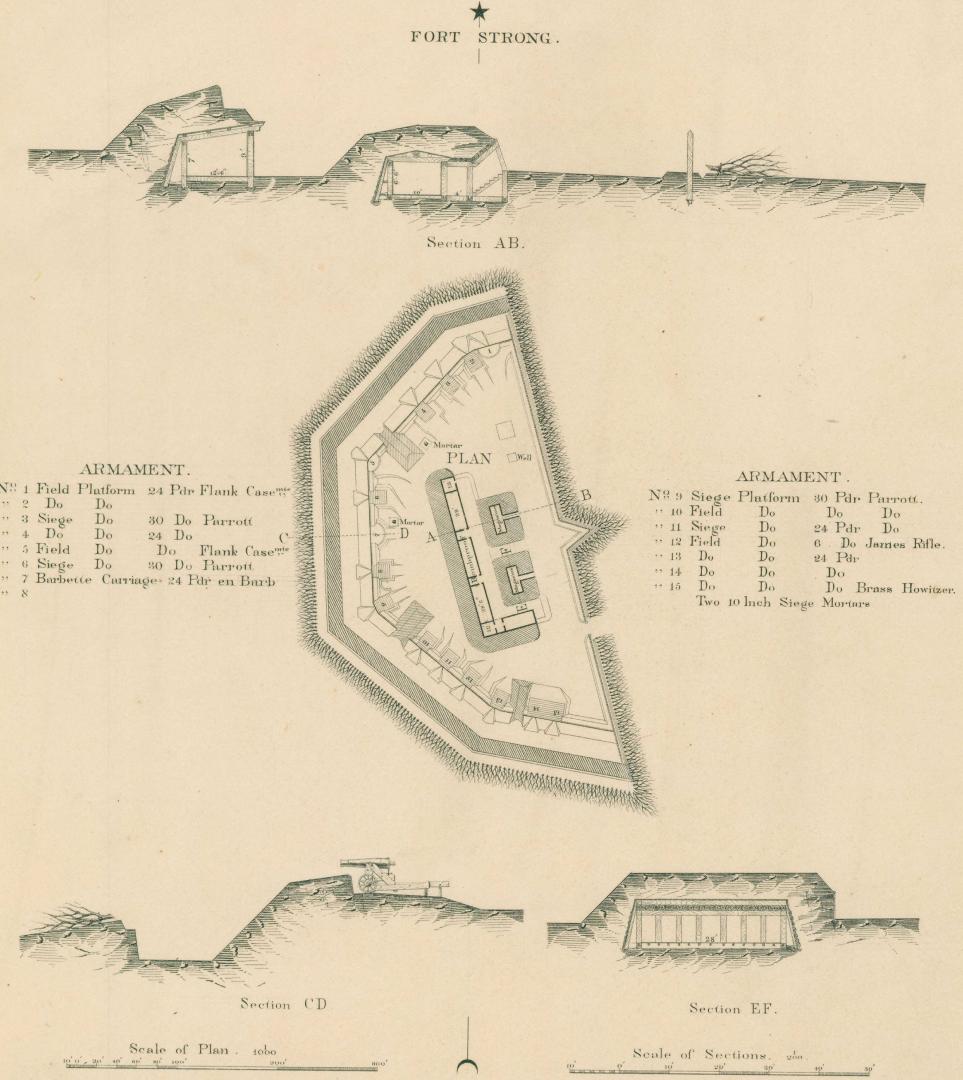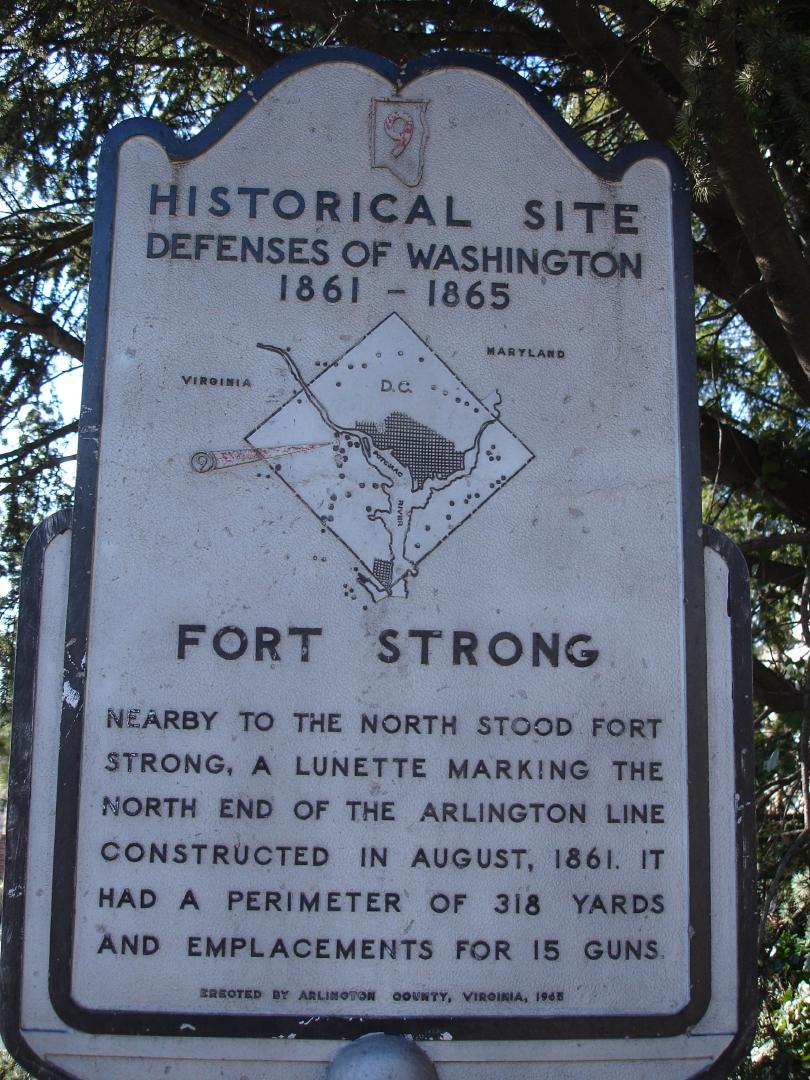Fort Strong on Arlington Heights

Fort DeKalb was renamed Fort Strong on November 4, 1863, after Major General George C. Strong, who had died July 30, 1863, of wounds received in an assault on Fort Wagner, Charleston harbor, S.C.
During the Civil War, Fort Strong, or DeKalb as it was first called, was an essential part of the system of defenses around Washington, D.C. There were 68 forts around Washington and 22 in what is now Arlington County. Some 18,000 men were stationed in Arlington, a community with a population of about 1,400.
Fort DeKalb was renamed Fort Strong on November 4, 1863, after Major General George C. Strong, who had died July 30, 1863, of wounds received in an assault on Fort Wagner, Charleston harbor, S.C. General Strong was from Vermont. He had graduated from West Point in 1857 and was only 30 when he died.
With the beginning of hostilities between North and South at Fort Sumter in April 1861, the capital city of Washington was challenged. Virginia would undoubtedly secede, leaving the Federal City facing a hostile shore without a strong defense. Across from Washington on the western bank of the Potomac River was in 1861, a range of thickly wooded hills 200-300 feet high. A short distance back from the bank of the river, they ran from Chain Bridge to the rear of the city of Alexandria. Artillery on these heights could threaten Washington, so retaining the commanding position in Federal hands was essential.
After the Battle of Bull Run, it became apparent that there was to be a struggle of long duration and that the city of Washington would have to be protected systematically. Federal officials realized that their defenses must be improved.
Gen. John Barnard, who was in charge of the Union defenses, described his plan:
"Thus, from a few isolated works covering Bridges or commanding a few essential points were developed a connected fortification system by which every prominent point, at intervals of 800 to 1,000 yards, was occupied by an inclosed field -fort. Every critical approach or depression of the ground, unseen from the forts, swept by a battery for field guns, and the whole connected by rifle trenches, which were lines of infantry parapet, furnishing emplacement for two ranks of men and affording covered communications along the line while roads were spaced wherever necessary so that troops and artillery could be moved rapidly from one point of the immense periphery to another or under cover, from point to point along the line."
Barnard added, "That to defend Washington on this side requires simply that the enemy shall be kept at such a distance from the banks of the Potomac that he cannot shell the city. This object is accomplished by the chain of works from Fort Scott to Fort DeKalb, resting its flanks on the Potomac, the left near Four Mile Run, and the right opposite Georgetown."
The right flank of this chain, Fort DeKalb or Strong, was located at the northern end of Arlington Heights to guard the roads and approaches to the canal aqueduct bridge (near the present-day Key Bridge, one of the supports of this bridge can still be seen near the Virginia side). The fort was three-quarters a mile west of Fort Corcoran, on a higher crest of the heights, overlooking Spout Run. It was a lunette with stockaded gorges, i.e., an open-ended semi-circular earthworks protected by log stockades at the rear. Rifle pits were dug outside the fort, like the one that can still be seen in Spout Run Park near the W&OD Railroad right-of-way.
Fort Strong had a perimeter of 318 yards and usually mounted about 15 guns-seven 24-pound guns, one 24-pound brass field howitzer, four 30-pound Parrotts, one six-pound field gun, and two 10-inch siege mortars. The fort required 141 gunners to supply five men for each heavy gun, three men for each field gun, and three reliefs. A regimental hospital was located at Fort Strong throughout the war. A "bombproof" was constructed within the fort in late 1863. The bombproof was an underground bunker to protect men and equipment from artillery fire.
Fort Strong was garrisoned until 1869, but with the war's end, it was no longer needed as an artillery base. In March of 1869, one corporal and three privates of the 12th U.S. Infantry were stationed at the fort guarding ordnance stores. On March 20, the ordnance property was removed. The guard rejoined its regiment, and the fort was abandoned.
The remains of Fort Strong could be seen until 1959 on the grounds of an Arlington home, Altha Hall, but both were destroyed in the construction of Potomac Towers.
Source:
John Gross Barnard, A Report on the Defenses of Washington to the Chief of Engineers, US Army. Washington: GSO. 1871; pp.33-34.
Images

